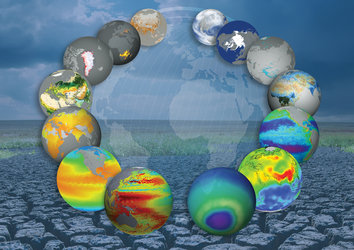Accounting for Earth’s water cycle
The amount of water on Earth is finite. Sustaining life, this precious resource has been circulating between Earth’s surface and atmosphere for over four billion years, and changing between a liquid, a solid and a gas along the way. Although the total amount of water within the cycle remains constant, the way it is split between its various reservoirs changes continually. With the climate crisis leading to more extreme droughts and floods, the availability of enough freshwater where we need it is a growing concern. How can we be sure that we are using our water resources sustainably?
Since the water cycle is a closed system, it should be possible to account for how much water moves in and out of Earth’s different water stores over time. Unfortunately, scientists cannot yet confidently account for where all the water is, the ‘water budget’. A review led by scientists from ESA’s Climate Change Initiative and published recently in the Bulletin of the American Meteorological Society explores why.
“We’ve made a lot of advances, especially in space-based observations of the water cycle. The Copernicus programme is proving vital for long-term, consistent satellite observations,” says lead author Wouter Dorigo, who is based at Vienna University of Technology.
The authors point to the Climate Change Initiative as it supports the development of global, long-term satellite datasets that cover many key components of the water cycle, including glaciers, ice sheets, sea level, soil moisture, lakes, snow, water vapour and permafrost.
While these data have helped improve the picture, there are still components and fluxes of the water cycle that satellites cannot monitor.
Dr Dorigo commented, “In particular, we don’t have accurate knowledge of the fluxes for groundwater use, recharge and natural discharge, which makes it difficult to project future sustainable use.”
Groundwater is, by far, Earth’s largest store of liquid freshwater, but decades of extraction has led to depleted aquifers in many regions around the globe.

Traditionally, groundwater is measured via boreholes or wells, but observation sites are sparse and the data often discontinuous. Gravity data from satellites such as that from NASA’s Gravity Recovery and Climate Experiment, GRACE, and GRACE Follow-On missions can be used to track groundwater dynamics. However, this is complicated because the gravity signals from overlying water reservoirs, such as lakes, snow, ice and moisture in soil, have to be removed before the signals can be used to account for groundwater.
“Currently, satellites alone cannot resolve the entire water budget balance. Coordinated measurements of groundwater from sensors in the ground is what we need most urgently, as well as more data on water used by us humans as well as data on river discharge,” continued Dr Dorigo.
The authors also call for improvements in how the global space-based records, such as those produced by the Climate Change Initiative, are integrated into models to derive the components of the water cycle that cannot be observed. They point to machine learning techniques to help reduce the uncertainties and biases for groundwater discharge and recharge, deep soil moisture and irrigation use, for example.
Susanne Mecklenburg, head of ESA’s Climate Office, said, “The recommendations in the report are helpful and confirm that ESA’s new climate programme is heading in the right direction by supporting how the essential climate variables work together to help understand Earth’s climate system.”
In the future, a better understanding of groundwater values will also come from a new gravity mission being developed within ESA’s FutureEO programme. ESA and NASA are currently working hard to realise the Next Generation Gravity Mission, also known as Magic. This ambitious new mission will ‘weigh’ water in all its various locations, including underground, to shed more light on water distribution and transport.









